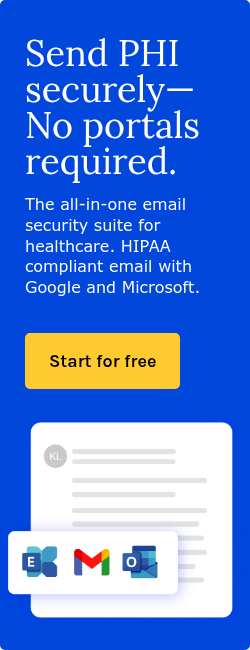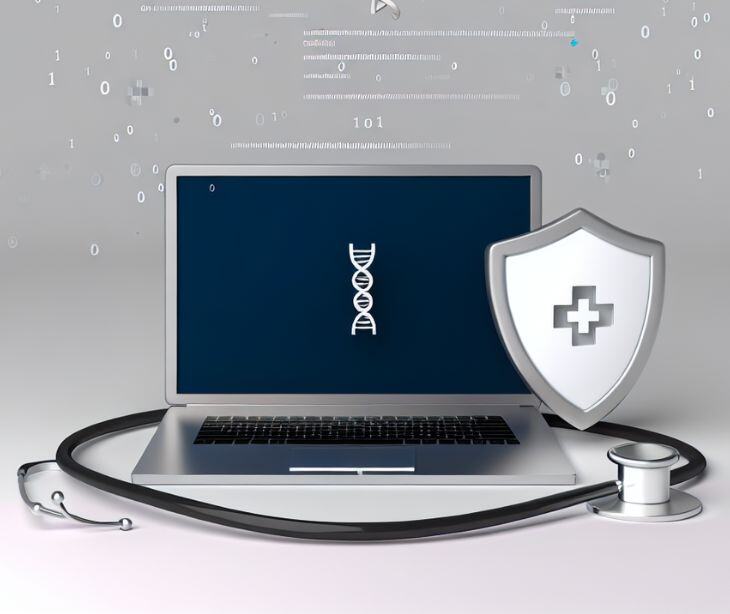5 min read
Cybersecurity checklist: Considerations for healthcare security strategies
Kapua Iao
June 20, 2025

According to the Health Information Sharing and Analysis Center (Health-ISAC), cyberattacks significantly affected healthcare organizations in 2024 and remain a top concern in 2025. In a recent survey, the organization found that healthcare executives are worried about ransomware, third-party breaches, supply chain attacks, zero-day exploits, and data breaches in general. Given such concerns, healthcare cybersecurity remains a priority, particularly under HIPAA.
The Health Insurance Portability and Accountability Act (HIPAA) is designed to protect patients’ protected health information (PHI) and keep it from being disclosed without a patient's consent or knowledge. In other words, cybersecurity is a fundamental part of HIPAA compliance. Healthcare organizations must learn how to prioritize their cybersecurity measures. Having a healthcare cybersecurity checklist on hand ensures that organizations understand what type of measures they need to utilize to keep themselves and patients safe.
Additional info: HIPAA compliant email: The definitive guide
The growing threat landscape
The World Economic Forum states that the healthcare industry remains a prime target for hackers and cybercriminals. As an example, the organization points to the fact that in 2023, for the 13th year in a row, the healthcare industry had the most expensive data breaches, costing on average $10.93 million. The healthcare industry, therefore, remains a focus of cyberattackers.
The rise in cyber intrusions against healthcare organizations can be attributed to several factors, including the following:
- The increasing value of PHI
- Outdated systems and software
- Insufficient cybersecurity measures
- The proliferation of medical technology and unsecured, connected devices
- Unprotected attack surfaces
- Tired and stressed employees
Patient data is highly valuable to cyberattackers, who may exploit unsecured systems and untrained staff to blackmail or target healthcare providers. Such data is also highly lucrative on the dark web. Sadly, given the constant strain put on hospitals and staff, healthcare organizations are more likely to comply with ransom demands.
Further info: Why healthcare is a major target for cyberattacks
Cyber threats to healthcare data
A cyberattack is an exploitation of computer systems through unauthorized access. Healthcare providers are vulnerable to a wide range of cyber threats that compromise patient data and disrupt operations. Here are some examples:
- Data breaches
- Phishing and social engineering
- Malware
- Ransomware
- Spyware
- Distributed denial of service (DDoS)
- Man-in-the-middle (MITM) attacks
- Internet of Things (IoT) attacks
- Insider threats
Attacks on the healthcare industry are unlikely to stop anytime soon and can have huge impacts on healthcare operations, including disruptions, confusion, high costs, loss of revenue, and even possibly patient deaths.
Cybersecurity and healthcare
In healthcare, it is obligatory to safeguard PHI and electronic protected health information (ePHI) with cybersecurity measures. Cybersecurity involves protecting computer systems, networks, and data from digital attacks, unauthorized access, and physical, emotional, and reputational damage. It also protects patient data, medical records, and healthcare organizations themselves from cyber threats and assists organizations with HIPAA compliance.
The HIPAA Privacy Rule sets the guidelines for using and disclosing patients' data. Then, the Security Rule sets the necessary administrative, physical, and technical safeguards healthcare organizations use to protect PHI. Effective measures help keep sensitive patient data confidential, secure, and compliant with HIPAA regulations.
A good HIPAA compliant cybersecurity approach includes multiple layers of strategies, protocols, and technologies that prevent unauthorized access and malicious attacks, keeping patients safe and secure. Moreover, a good strategy should include staff training, perimeter defenses, and offensive approaches. Cybersecurity cannot eliminate the risk of data breaches in healthcare, but it can significantly reduce their likelihood and impact.
Cybersecurity negligence
Understanding why cybersecurity negligence occurs is critical to preventing it. Negligence in cybersecurity refers to the failure of an individual, organization, or provider to implement reasonable safeguards to protect data, networks, and systems from cyber threats. Most organizations don’t set out to ignore security, they simply operate under assumptions, constraints, or circumstances that make them vulnerable.
Cybersecurity negligence can occur because of substantial or trivial errors, with both sometimes having minor, and others major, consequences. For example, organizations might forget to update or patch software while others might not enact a password policy. Furthermore, they might underestimate risks, lack adequate expertise, have poor oversight or complex systems and environments, and may be in the middle of organizational inertia.
Finally, poor employee training can lead to numerous errors, with at least 85% of breaches attributable to mistakes made by staff. By unpacking the root causes of negligence, organizations can identify practical ways to shift behaviors and create a comprehensive strategy to combat such issues.
Unique challenges to healthcare cybersecurity
There are several unique challenges healthcare organizations face when implementing cybersecurity within the industry:
- Securing electronic versus paper medical records
- Safeguarding large amounts of patient data
- Sharing sensitive information with patients securely
- Figuring out what PHI needs to be shared, to who, and when
- Ensuring there are no long periods of downtime
- Focusing on patient care as much as security
- Working with small budgets and limited capabilities
- Guaranteeing HIPAA compliance
Such trials demonstrate that healthcare organizations have a hard time delivering patient care and executing their cybersecurity strategy at the same time. Nevertheless, implementing a strong cybersecurity program means organizations can prevent data breaches, avoid substantial fines, and ensure that they meet HIPAA’s security and privacy requirements.
A healthcare cybersecurity checklist
Healthcare organizations must find the right cybersecurity strategy that works for them and their specific needs. The following healthcare cybersecurity checklist should be considered by healthcare organizations when creating their cybersecurity approach, along with other questions that may come up as they explore their options.
- Write out the needs, strengths, and weaknesses of your current security systems
- Analyze the security needs of your current patients and their health concerns
- Explore current security practices in place and how they mitigate specific risks
- Explore new security practices to consider implementing
- Consider several layered defensive and offensive methods to protect PHI
- Decide the best approach to training staff on PHI protection, HIPAA, and cybersecurity
- Plan for a breach and a disaster and its aftermath
- Perform regular maintenance and checks on the current strategy and update it regularly
Finally, as always, stay on top of changes to HIPAA and other state/federal regulations.
Read about: How to establish a strong security culture in your practice
A strong cybersecurity strategy means HIPAA compliance
HIPAA requires strict control over patient information and imposes significant penalties for violations. A strong cybersecurity strategy can help healthcare institutions meet regulatory requirements and avoid legal consequences and significant fines. By implementing strong cybersecurity practices, healthcare organizations can prevent data breaches and keep patients safe while focusing on patient care.
Implementing a wide-ranging cybersecurity program also encourages organizations to streamline operations and reduce costs. By taking a proactive approach to cybersecurity, healthcare organizations can mitigate the risk of cyberattacks and protect sensitive patient data. Cybersecurity shields PHI from breaches and unauthorized access, which is central to maintaining patient privacy and confidentiality. Even if a breach occurs, strong cybersecurity protocols can detect an intrusion quickly, minimize the damage, and expedite recovery.
FAQs
Why are cyberattacks a concern for HIPAA compliance in healthcare settings?
Cyberattacks are a concern because they can result in data breaches, unauthorized access to PHI, and operational disruptions. These outcomes can lead to HIPAA violations, financial penalties, and severe reputational damage for failing to protect patient information.
What are the consequences of cyberattacks on healthcare organizations?
- 20% of hospitals that experienced a cyberattack reported an increase in patient mortality
- Ransomware is the most disruptive type of attack that leads to the most operational delays
- 90% of healthcare organizations reported a loss in revenue after a cyberattack
Can a business be held legally responsible for cybersecurity negligence?
Yes. If negligence results in a data breach, organizations can face lawsuits, regulatory fines, and penalties under laws like GDPR, HIPAA, or state-level data protection acts.
See also: Case studies: HIPAA violations and their consequences
How can I protect my personal information online?
To protect your personal information online:
- Use strong, unique passwords for each account and enable multifactor authentication
- Be cautious of unsolicited emails and messages asking for personal information
- Keep your software and systems updated with the latest security patches
- Use reputable antivirus and antimalware programs
How do I create a strong password?
A strong password should be at least 12 characters long and include a mix of uppercase and lowercase letters, numbers, and special characters. Avoid using easily guessable information like birthdays or common words. Consider using a password manager to generate and store complex passwords.
Learn more: Guide to HIPAA compliant password requirements
Subscribe to Paubox Weekly
Every Friday we'll bring you the most important news from Paubox. Our aim is to make you smarter, faster.




